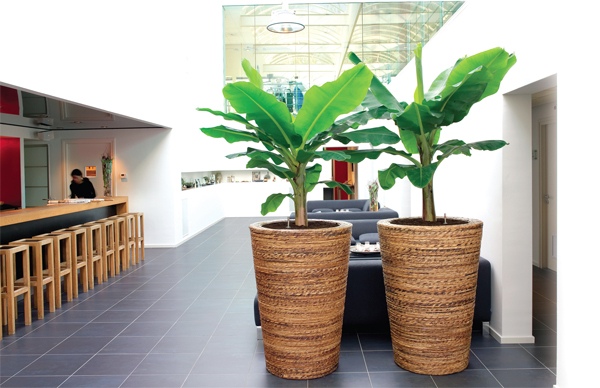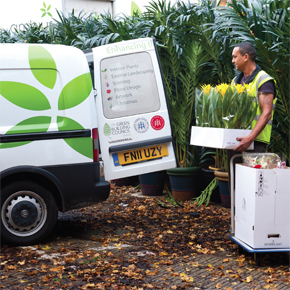
Greenery – the benefits beyond aesthetics
Kenneth Freeman, head of innovation at Ambius, discusses how to create a great first impression using plants and replica foliage and looks at the added benefits of both indoor and exterior planting…
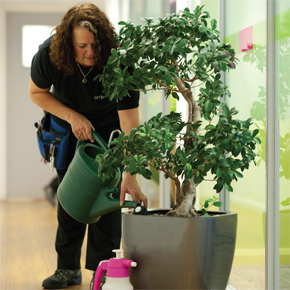 Whether it is a town hall, leisure centre or a recreational space next to social housing, the landscape design, and its maintenance, is as much a representation of an organisation as the building itself.
Whether it is a town hall, leisure centre or a recreational space next to social housing, the landscape design, and its maintenance, is as much a representation of an organisation as the building itself.
An aesthetically pleasing and a well-maintained landscape gives a positive first impression before a person even interacts with staff and services.
There is also a growing recognition of the need for multi-functional landscapes that bring additional health and wellbeing benefits to both staff and visitors alike.
Creating an exterior landscape
The public sector continues to deal with budget constraints and a continued emphasis on doing more with less. With this in mind, an exterior landscape doesn’t have to be created from scratch and can be achieved relatively inexpensively. It is possible to create an impressive interior landscape for, typically, much less than 1% of a building’s annual running costs, yet the benefits can often far outweigh those costs, resulting in a genuine return on investment.
Workspace plant design experts are able to advise on how to tailor plants and shrubbery to meet specific needs. There are a number of key considerations surrounding landscape design. At the fore should be the end user, so it is important to consider who you want to use the space and for what purposes, e.g. relaxation, as a thoroughfare for leisure. Do you want plants that will attract bees and other beneficial insects? What about using edible plants, such as herbs or even fruit trees, for a community garden or orchard?
Another consideration is how to integrate the planting with an organisation’s corporate identity. Corporate colours can be used with exterior planting to bring colour into the mix. Consider the use of creating planting beds that feature hardy, colourful plants with year-round interest. Take, for example, hanging baskets and window troughs – both live and artificial plants can be used throughout the year to maintain freshness and vibrancy.
Ongoing grounds maintenance is essential to uphold standards and to ensure that care and attention is given to the exterior planting. Services may include grass cutting, leaf clearance, seasonal bedding planting, pruning and even snow clearance and gritting in the winter months.
The added benefits of exterior planting
The benefits of exterior planting reach beyond making a strong first impression. Trees and hedges around the outside of a building can help bring heating costs and energy consumption down in winter by providing shelter and insulation. Well-placed foliage, such as trees and shrubs, can help to conceal unpleasant views and reduce noise pollution.
Screens of ivy and other dense foliage are also known to be effective in reducing pollution, including harmful diesel particulates. In addition, concealed planters containing ashtrays and rodent bait stations can be used where they are needed, even if you don’t want people to see them.
Heading inside
Plants and greenery are by no means solely for the exterior of a building. Whether you’re looking for a living green wall or a potted desk plant, the benefits are not only aesthetic but can actually improve the wellbeing of the personnel within a building.
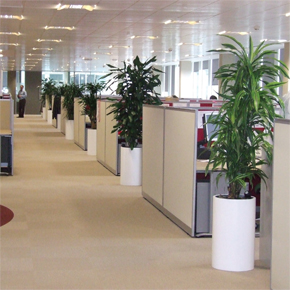 A report by Marlon Nieuwenhuis and her colleagues at the Universities of Cardiff, Exeter, Queensland and Groningen, supported by Ambius, revealed that plants in office spaces can increase employee productivity by 15% and improve workplace satisfaction by up to 40%.
A report by Marlon Nieuwenhuis and her colleagues at the Universities of Cardiff, Exeter, Queensland and Groningen, supported by Ambius, revealed that plants in office spaces can increase employee productivity by 15% and improve workplace satisfaction by up to 40%.
Additionally, research has consistently shown that when buildings have plants, reports of symptoms associated with Sick Building Syndrome (SBS) frequently fall – often quite dramatically. In addition plants in offices have been shown to:
- Reduce blood pressure (lowered by 1–4 units)
- Reduce complaints about fatigue by as much as 30%
- Reduce coughing by up to 40%
- Reduce complaints of dry skin by 25%
Creating the feel of nature indoors
Indoor planting is a simple way of creating a natural environment. A simple floor-standing container filled with planting or larger freestanding trees are both ways of bringing the outside in. Another way of doing this is by blurring the boundary between inside and outside using interior landscaping to draw the eye to the outside world, by placing plants close to or next to windows.
Furthermore, there have been a number of design developments that can provide a high level of greenery without encroaching on valuable space, such as living room dividers and framed plant art.
The future of planting in the workspace
The realisation of the importance of plants in the workplace has led to new standards when it comes to the design and construction of workspaces. The WELL Building Standard (WELL), for example, which is administered by the International WELL Building Institute (IWBI), is the world’s first building standard focused exclusively on human health and wellness.
WELL aims to ensure built environments help to improve the nutrition, fitness, mood, sleep, comfort and performance of the occupants, and it is the culmination of research by scientists, doctors, architects and wellness thought leaders.
The initial standard was launched in the US in October 2014, with a number of UK businesses now realising the proven benefits behind improving the built environment.
The research used to develop WELL alongside wider academic study, clearly demonstrate how a green and enriched workspace, inside and out, can positively influence wellbeing. Public sector organisations that do rethink their environment are likely to benefit from improved positive perceptions from the public, employees and stakeholders alike.
Latest news
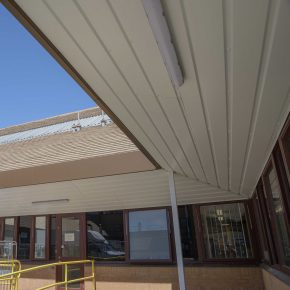
26th April 2024
Alumasc Skyline and Rainwater package specified at Weston-super-Mare Hospital
A package of products from Alumasc Water Management Solutions (AWMS) has been used for the external refurbishment of the roofline at Weston General Hospital in Weston-Super-Mare.
Posted in Aluminium Products, Articles, Building Industry News, Building Products & Structures, Building Services, Building Systems, Case Studies, Cladding, Drainage Services, Drainage, Guttering, Soffits & Fascias, Fascias, Restoration & Refurbishment, Retrofit & Renovation, Roofs, Walls
26th April 2024
Hush Acoustics optimises fleet operations by securing FORS Gold accreditation
Hush Acoustics has invested in the safety and sustainability of its commercial vehicle fleet by achieving Gold status in the Fleet Operator Recognition Scheme (FORS).
Posted in Acoustics, Noise & Vibration Control, Articles, Building Industry News, Building Products & Structures, Building Regulations & Accreditations, Building Services, Ceilings, Facility Management & Building Services, Floors, Health & Safety, Insulation, Restoration & Refurbishment, Retrofit & Renovation, Site Preparation, Sustainability & Energy Efficiency, Walls, Waste Management & Recycling
26th April 2024
Safeguard Europe: Penetrating damp - how to diagnose the damage
As Safeguard gets ready to deliver another informative session of one of its most popular webinars, the company outlines some of the most common reasons for rain penetration through brickwork.
Posted in Articles, Bricks & Blocks, Building Industry Events, Building Industry News, Building Products & Structures, Building Services, Continuing Professional Development (CPD's), Damp & Waterproofing, Facility Management & Building Services, Information Technology, Posts, Render, Restoration & Refurbishment, Retrofit & Renovation, Seminars, Training, Walls
25th April 2024
ADSA: Competence Initiative Makes Progress
The Joint Competency Initiative (JCI), in which the Automatic Door Suppliers Association (ADSA) is involved, is finalising its first framework for installers within the door, gates and shutter industry.
Posted in Access Control & Door Entry Systems, Architectural Ironmongery, Articles, Building Associations & Institutes, Building Industry Events, Building Industry News, Building Products & Structures, Building Regulations & Accreditations, Building Services, Continuing Professional Development (CPD's), Doors, Facility Management & Building Services, Health & Safety, Innovations & New Products, Publications, Research & Materials Testing, Restoration & Refurbishment, Retrofit & Renovation, Security and Fire Protection, Site Preparation
 Sign up:
Sign up: 